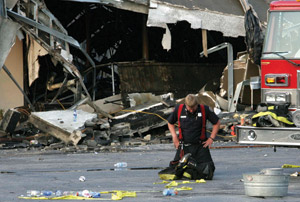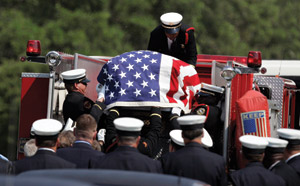
Features
Structural
Training
Trainer’s Corner: The need to practise mayday
I recently received a call from my son Aaron (a firefighter and columnist for Canadian Firefighter and EMS Quarterly) in regard to what has come to be known as the Charleston Nine.
September 18, 2008
By Ed Brouwer
I recently received a call from my son Aaron (a firefighter and columnist for Canadian Firefighter and EMS Quarterly) in regard to what has come to be known as the Charleston Nine. Aaron had listened to several hours of audio recordings of the nine firefighters’ last transmissions. In the moments before a furniture store fire took their lives, some of the nine killed shouted “Mayday!” and recited prayers. Another said “I love you.” Then, firefighters tell their colleagues to stay off the radio system. As that order ends, a voice issues a traditional prayer ending: “In Jesus name, amen.”

Listening to the tapes from the Charleston Sofa Super Store fire, it became clear that the fragmented messages of distress were not heard.
|
For those who do not know, the Charleston, S.C., fire was reported as the U.S.’s deadliest single disaster for firefighters since the Sept. 11 terrorist attacks. Fire swept through a warehouse, collapsing its roof and killing nine firefighters inside. Two employees in the building were rescued from the blaze, which broke out at about 19:00, Monday, June 18, 2007, in the Sofa Super Store and warehouse.
Knowing my drive to get the Canadian fire services to include mayday procedures in all rookie and fire-officer training (including dispatchers), Aaron informed me of the investigation’s findings.
Water issues, inadequate training, no truck operations, building-code violations, communications problems and no incident commander were just a few issues cited in the Phase II report on the deadly Sofa Super Store fire. The investigation/report is one of the most definitive and complete post-incident fire analyses ever conducted. The panel made several critical recommendations before the review started, resulting in operational and staffing changes in the Charleston Fire Department. When retired fire chief Gordon Routely, who headed the review panel, finished presenting the panel’s critical analysis, an emotional Charleston Chief Rusty Thomas stood before the packed room and accepted responsibility for the deaths of his nine friends. “I knew every single one . . . I’m so sorry that myself or somebody could not have done something differently that night to bring back those nine guys.”
One firefighter, who realized a supply line had not been established, turned the corner to find the hydrant missing. It had been removed because delivery trucks kept hitting it. Unaware where the next hydrant may be, he set out on foot to look. He found one, but wound up 100 feet short of hose. He had to couple the lengths by hand. While that was underway (about nine minutes), 16 firefighters were in the burning building with a booster line and a 1.5-inch hose.
Timed pictures of the fire’s development – taken from across the road – showed heavy smoke and flames from the roof. Routely said the firefighters inside had no idea what was going on above them. He noted that almost every firefighter who arrived went into the building, including those on the ladder truck. “They were entering the building by ones and twos . . . .”
Routely said although officers were hearing of deteriorating conditions, none of the chiefs made a decision to evacuate the store and move from an offensive to a defensive attack. That decision didn’t come until after several disoriented firefighters had been rescued.
There was no accountability whatsoever. There is no suggestion that any CFD members lost or surviving failed to perform their duties as they had been trained or as expected by their organization. The final analysis does indicate, however, that the CFD failed to adequately prepare its members for the situation they encountered at the Sofa Super Store fire.
As I listened to the fire ground tapes and read the 44 pages of radio transmission and phone call transcripts, it became all too clear that the fragmented messages of distress were not heard. There was no mayday plan in place. Firefighters were unclear when to call for a mayday and had little if any idea what to do to save themselves while waiting to be rescued.

The Charleston, S.C., fire was reported as the U.S.’s deadliest single disaster for firefighters since the
Sept. 11 terrorist attacks. |
According to the transcripts, the first radio traffic related to firefighters in trouble was at 19:27, but it was not heard by anyone on the fire ground. At 19:29 there is more radio traffic from firefighters lost and looking for help. Again, no one can hear them on the fire ground. At 19:30, a firefighter driving to the fire ground in his own car hears the radio distress calls and tries to reach a chief to tell him about it but can’t get through. At 19:31, the now-famous rescue of an employee trapped inside the building is made by cutting through the wall. At 19:32, the mayday call is finally heard and a chief tells everyone to stay off the radio to listen for those calls. Throughout the calls, PASS alarms are sounding but there is no notice taken. At 19:33 the firefighter travelling to the scene gets out of his car and tells a chief face to face what he has heard. The call goes out for everyone to come out and be accounted for. At this point, according to the transcript, it is becoming a little chaotic and firefighters are losing each other and struggling to get out. The fire is rapidly expanding. At 19:38 Chief Thomas orders a full evacuation. By 19:40 the interior is fully involved and the last firefighters who will survive are getting out of the building. There are several heart-wrenching times when you know a mike is being keyed and all you hear is radio static and PASS alarms. It wasn’t until 22:00 that search and recovery began.
Although this happened in the U.S., we need to be aware of it and learn from it. We must do everything we can to prevent this from happening to any of our firefighters. We must get this right to honour our nine brothers: Capt. William Hutchinson, 48, 30 years of service; Capt. Mike Benke, 49, 29 years of service; Capt. Louis Mulkey, 34, 11.5 years of service; engineer Mark Kelsey, 40, 12.5 years of service; engineer Bradford Baity, 37, nine years of service; assistant engineer Michael French, 27, 1.5 years of service; firefighter James Drayton, 56, 32 years of service; firefighter Brandon Thompson, 27, four years of service; firefighter Melvin Champaign, 46, two years of service.
What is your department’s mayday policy? Does your department train on it? It is my conviction that both firefighters and officers need to experience what it may be like to call a mayday before it is the real thing. If you put on SCBA and enter IDLH environments, you need to drill on calling a mayday.
Why is it so difficult to get a firefighter to call a mayday? We treat speaking about mayday to our firefighters as a young father does in talking to his children about sex. Our discomfort in talking about “it” tends to leave it up to the kids to find out from his or her street friends.
The way firefighters react to any situation is based on their training and experience. If they do not have mayday calling in their experience, calling the mayday will not come naturally when the need arises.
Mayday comes from the French term m’aider, an imperative that means “help me.” Mayday was adopted as a distress call by the International Radio Telegraph Convention in 1927. In international radio language, “Mayday, mayday, mayday,” means “Life is in danger. Immediate help needed!” The average firefighter practises tying knots more than calling mayday. The firefighters’ mayday calling system, which includes a radio, a firefighter, an IC and a dispatcher, is not tested and drilled to ensure the system works.
How many funerals do we need to attend? If a task has a low use level but very high consequences for failure, that task must be taught to the highest level of performance and drilled continually to maintain competency. We are talking about the greatest resource in the Canadian fire service – our firefighters.
It is imperative that our fire departments develop rules for when a firefighter must call a mayday. If need be, give permission to your firefighters to call a mayday. The next hurdle is training ICs what to do should they hear a mayday. Among the 272 pages of the NIOSH report were the following lines: “The communications process was not controlled. The fire chief, the assistant chief, and battalion chief were all issuing orders and providing direction independently, using a single overloaded radio channel. Critical messages, including distress message from firefighters inside of the structure, were not heard.”
Ed Brouwer is the chief instructor for Canwest Fire in Osoyoos, B.C., and the training officer for West Boundary Highway Rescue. The 19-year veteran of the fire service is also a fire warden with the B.C. Ministry of Forests a wildland interface fire suppression instructor/evaluator and a fire-service chaplan. E-mail: ed@thefire.ca
| Three simple steps that could save your life ■ Push the emergency identifier button (EIB) on the radio. This captures the channel for 20 seconds, gives an open mike to the radio (in other words the firefighter does not need to push the talk button on the radio), and sends an emergency signal to radio communications identifying the radio. ■ Announce MAYDAY, MAYDAY, MAYDAY. ■ Give LUNAR: L location; U unit number; N name; A assignment (What were you doing?); R resources (what do you need?). Three recommendations ■ Include mayday calling in all training where firefighters are put into simulated IDLH conditions. ■ Get communications involved. |
Print this page